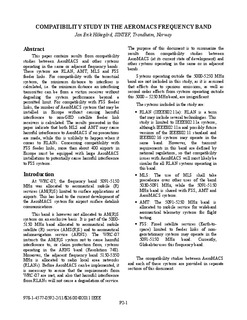| dc.contributor.author | Håkegård, Jan Erik | |
| dc.date.accessioned | 2017-02-21T08:25:40Z | |
| dc.date.available | 2017-02-21T08:25:40Z | |
| dc.date.created | 2012-02-21T14:45:26Z | |
| dc.date.issued | 2011 | |
| dc.identifier.citation | Integrated Communications, Navigation and Surveilance Conference (ICNS), 2011 : Herndon 10-12 May 2011 | nb_NO |
| dc.identifier.isbn | 978-1-4577-0593-9 | |
| dc.identifier.uri | http://hdl.handle.net/11250/2431528 | |
| dc.description.abstract | This paper contains results from compatibility studies between AeroMACS and other systems operating in the same or adjacent frequency bands. These systems are RLAN, AMT, MLS and FSS feeder links. For compatibility with the terrestrial systems, the minimum distance to interferer is calculated, i.e. the minimum distance an interfering transmitter can be from a victim receiver without degrading the system performance beyond a permitted limit. For compatibility with FSS feeder links, the number of AeroMACS systems that may be installed in Europe without causing harmful interference to non-GEO satellite feeder link receivers is calculated. The results presented in this paper indicate that both MLS and AMT may cause harmful interference to AeroMACS if no precautions are made, while this is unlikely to happen when it comes to RLANs. Concerning compatibility with FSS feeder links, more than about 400 airports in Europe must be equipped with large AeroMACS installations to potentially cause harmful interference to FSS systems. | |
| dc.language.iso | eng | nb_NO |
| dc.relation.ispartof | Integrated Communications, Navigation and Surveilance Conference (ICNS), 2011 : Herndon 10-12 May 2011 | |
| dc.title | Compatibility Study in the AeroMACS Frequency Band | nb_NO |
| dc.type | Chapter | nb_NO |
| dc.source.pagenumber | P2-1-P2-14 | nb_NO |
| dc.identifier.cristin | 910956 | |
| cristin.unitcode | 7401,90,22,0 | |
| cristin.unitname | Kommunikasjonssystemer | |
| cristin.ispublished | true | |
| cristin.fulltext | postprint | |
| cristin.qualitycode | 1 | |
